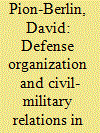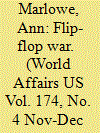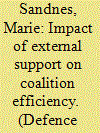| Srl | Item |
| 1 |
ID:
086661


|
|
|
|
|
| Publication |
2009.
|
| Summary/Abstract |
This study examines how defense institutions and personnel are formally organized in Latin America. In a region long plagued by praetorian armies, it is especially important that organizational designs ensure that civilians maintain institutional control over armed forces. For this to occur, it is argued that those designs must incorporate certain principles: (a) enhance the civilian presence in key defense institutions, (b) empower defense ministries, (c) lower the military's vertical authority along the chain of command, and (d) unify civilian power while dividing military power. Based on an examination of legal documents and other data for sixteen Latin American democracies, findings show three general organizational patterns: an ideal-typical defense structure that achieves all four objectives, a second best defense structure that still leaves too much military power unified, and a dual command structure that is least desirable for weakening the defense ministry while coalescing military might high up the ladder of influence.
|
|
|
|
|
|
|
|
|
|
|
|
|
|
|
|
| 2 |
ID:
108852


|
|
|
| 3 |
ID:
192609


|
|
|
|
|
| Summary/Abstract |
This article examines the extent to which external actors influence the efficiency of the G5 Sahel Joint Force’s (G5S-JF) chain of command and what this means for the relationship between the G5S-JF and external actors. I argue that external actors have taken leading roles within the G5S-JF’s chain of command and that this external influence has increased the efficiency of the joint force’s command. This suggests that the relationship between the G5S-JF and external actors follows the logic of hegemonic theory, with external actors providing efficiency and stability through a strong leading voice, as other scholars have previously assumed. However, I demonstrate that there are limitations to a hegemonic understanding of this relationship, as it does not take into account the agency of the joint force. In fact, as things have developed, the hegemonic stability logic rather appears to have been proven wrong as the strong leading role of external actors was a contributing factor to Mali’s withdrawal in May 2022 and the subsequent instability of the joint force.
|
|
|
|
|
|
|
|
|
|
|
|
|
|
|
|